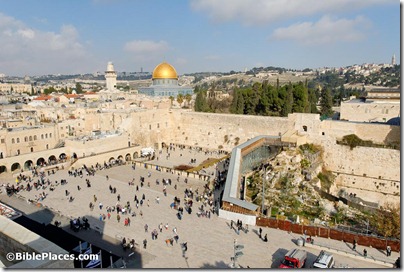Relief from the afternoon sun is not in sight at the Western Wall prayer plaza because of a rabbinic decree that forbids anything that will overshadow the Wall. From Haaretz:
It was a beautiful, partially cloudy spring day in Jerusalem on Tuesday, with temperatures reaching 25 degrees Celsius in the shade. A perfect day for strolling around nearly any part of the city, with one truly glaring exception: the Western Wall Plaza. The glaring whiteness of the plaza pavement reflected the heat, and the complete absence of trees, buildings and pergolas ensured that there was not a speck of shade. The result is an almost unbearable experience for worshipers and tourists who congregate at Judaism’s holiest site. The situation will only become worse with the arrival of summer.
[…]
“I was at a bar mitzvah on the eve of Passover, which isn’t yet summer, and people said it was impossible to concentrate on the prayers,” recalls Ofer Cohen, chairman of an NGO, called the Lobby for Jewish Values. “Anyone who prays when it is hot has to finish the prayer quickly – it isn’t praying with a focused mind,” says Cohen, who has asked the ministers of tourism and religious affairs to try to solve the problem.
Tour guides are also irked by the harsh conditions at the plaza.
“The problem exists all year around, both in the rain and in the sun,” says Jerusalem guide Ben Lev Kadesh. “In this whole huge space there isn’t a single covered corner. Many of the tourists come from Europe and it isn’t easy for them to stand in the sun.”
[…]
Indeed all ideas for providing some kind of cover or shade in parts of the plaza have been rejected. The problem has been under discussion for decades, say officials in Rabinovitch’s office. “There have been discussions about how to deal with heat in summer and rain in winter. But most people from the areas of planning, history and archaeology have felt strongly that for the sake of the Wall’s splendor, glory, and the memory of the past, the Western Wall should be revealed without means of shading,” say the officials.
The full article is here.

